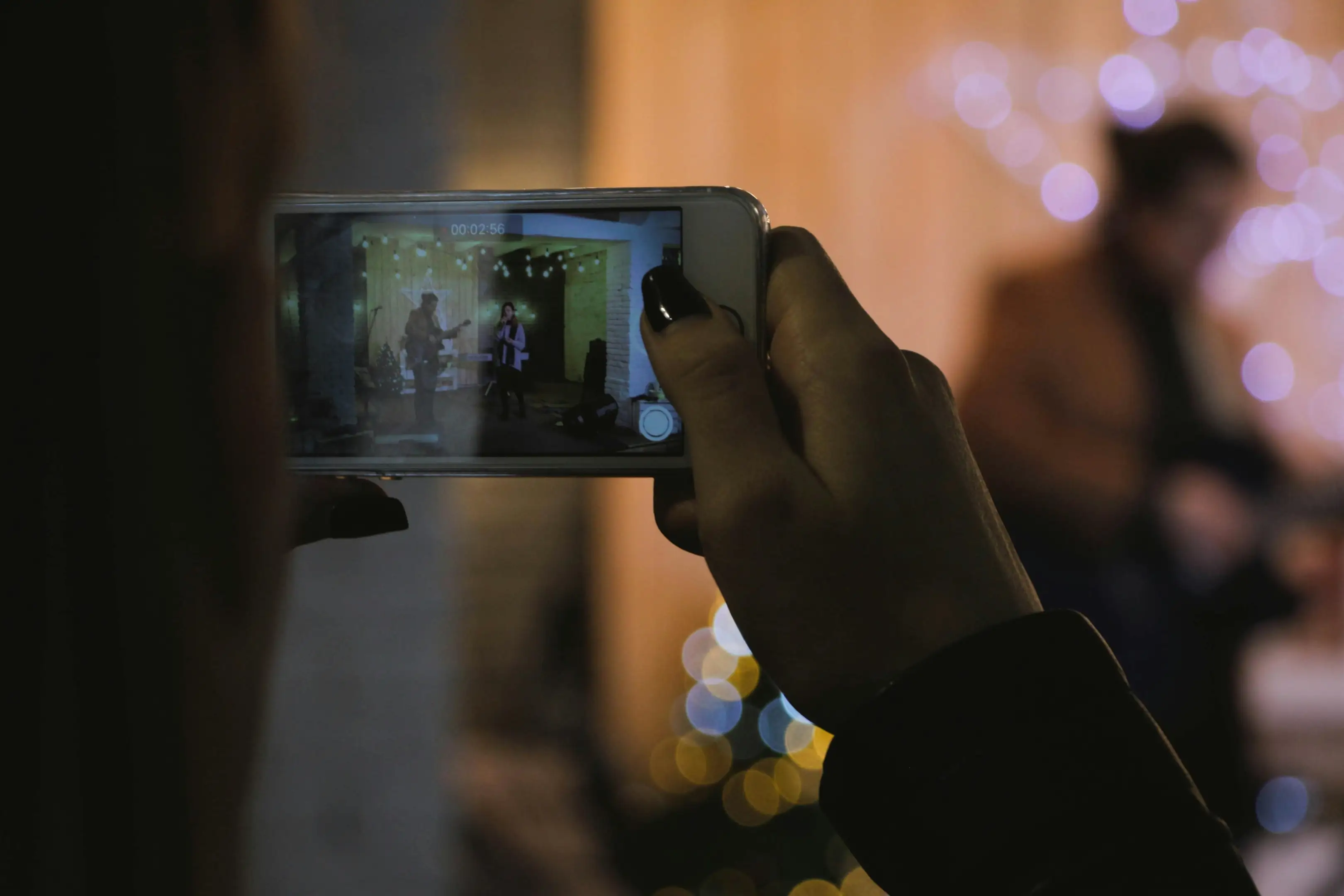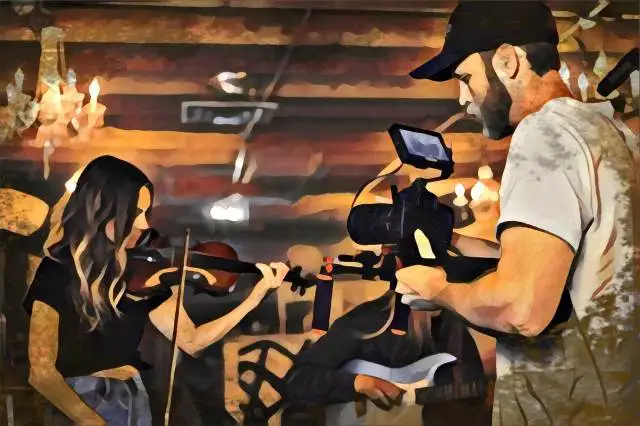With the prominence of music and video-associated content today, it's hard to imagine a world in which music videos, or the basic premise behind them, essentially did not exist. However, it's not all that long ago that pairing visuals with music felt like a foreign concept: the evolution of music videos has been impressive and swift.
Below, we'll detail the rapid transformation of music videos as we know it, looking back into music history to help provide important context for this current age of media and beyond.
The History of the Music Video: Pre-MTV to Today
Understanding the rise from the first music videos to the abundance of music-focused content we have today is anything but linear. While some events depicted in the sections below inevitably overlap, here is the general history behind how the music industry, and the culture behind it, invented music videos:
The First Music Videos: Vitaphone Shorts, Soundies and Early Iterations
There were many precursors to what we might consider a traditional music video today:
Vitaphone Shorts
Warner Brothers produced a series of short films entitled "Vitaphone Shorts". These short films featured many dancers, bands, and vocalists.
Soundies
Soundies were short, musical films produced for inserts within the Panoram film jukebox. These musical films included choreographed dance sequences which left a legacy for musical films and eventually music videos following their release.
Bessie Smith and St. Louis Blues
A two-reel short film was created for Bessie Smith's music, dramatizing the performance of the hit song St. Louis Blues . This film served as a catalyst, energizing other popular musicians of the time to create their own short films to promote their music.
Louis Jordan and Lookout Sister
Louis Jordan created several short films to accompany his music predating the 1960s. These clips were compiled into a feature film entitled Lookout Sister .
The Big Bopper
In 1959, The Big Bopper otherwise known as Jiles Perry, used the first public recorded instance of using the term "music video." As noted above, Jiles Perry was not the first to put music to video though it's clear this time the concept was beginning to enter the public consciousness. Musician Tony Bennett claims to have created "the first music video" for his song Stranger in Paradise , though the holder of this title is difficult to define and determine based on your definition of the concept:
The Development of Early Music Television Shows
Once sound started to be paired with visuals, there was no stopping the prevalence of music-focused TV programming:
Scorpitone
The Scorpitone machine served as a visual jukebox, offering 16 mm short films paired with musical accompaniment. These early music video iterations were made in 1959 in France.
Manny Pittson and Singalong Jubilee
Manny Pittson developed a Canadian show called Singalong Jubilee . This program would include music paired with various visuals and artists lip-syncing to their songs.
Top of the Pops
Johnnie Stewart created the Top of the Pops , a British Chart music television show. The show's demand for appearances from the week's rotating cast of characters led to the need for pre-recorded material from artists. Roy Orbinson's song Oh Pretty Woman included a notable dance number which set an important precedent for music videos.
Help! and The Beatles
The Beatles film, Help! featured an opening title sequence that served as a model for the modern music video. Set to music with dynamic shots, cuts, and interspersed performance videos, this film pushed the budding medium forward.
Sounds Unlimited and Video Concert Hall
Many people mistakenly accredit MTV with the first iteration of music videos, but the truth is that there were several precursors to the famous show:
Sounds Unlimited
In 1975, DJ Graham Webb launched a TV music show called Sounds Unlimited, and later just Sounds . Webb approached newsroom staffers to shoot film footage to serve as accompanying video for songs like Hary Nillson's Everbody's Talking .
Bohemian Rhapsody by Queen
Also in 1975, Bruce Gower shot a promotional music video for Bohemian Rhapsody . This widely successful campaign stood as an example of one of the first videos where video promotion was essential to the commercial success of the song.
Video Concert Hall
Launched in November of 1979, Video Concert Hall was the first nationwide programming focused on music videos. It predated MTV for about two years and was created by Jerry Crowe and Charles Henderson.
Ashes to Ashes by David Bowie
Ashes to Ashes by David Bowie became the first music video to exceed a budget of over half a million dollars. Its complex nature and several featured locations made it essential in the furthering of the medium.
The Creation of MTV and Residual Impact
As you might expect the creation of MTV and other music video-focused television created a lasting impact on the appetite and consumption for music videos. The first video to be featured on MTV is appropriately, Video Killed the Radio Star by The Buggles. This clip was originally created in 1979 and played on MTV in 1981.
The iconic video for Thriller by Michael Jackson set new standards for production, with the video costing $800,000 to film. Michael Jackson's music was instrumental for blazing the trail for getting black artists featured on TV.
In 1983, CMT (Country Music Television) is launched. VH1 is launched in 1985, intending to play softer, more relaxed music intended to capture the baby boomer audience.
The Golden Age of Music Videos
Before the age of streaming, artists and music video directors enjoyed an abundance of high-budget collaborations:
Directorial Crossover
Many prominent directors began cutting their teeth on music videos, before moving to feature films. Some of the most prominent names include Spike Jonze, Mark Romanek, and David Fincher.
The Most Expensive Music Videos of All Time
At this time, making music videos with enormous budgets was possible due to the profitability of the music industry. The music video for Scream by Michael and Janet Jackson is the most expensive video of all time, costing a staggering 7 million dollars. Honorable high-budget mentions include Bedtime Story by Madonna.
Billboard's Music Video Awards
Between 1991 and 2001, Billboard conceives separate Music Video Awards. These awards celebrated the medium's accomplishments irrespective of the associated music's chart placement.
Modern Reinvention
Today, music videos hardly resemble those of the past. These are some of the major modern events that led up to where we stand today in the music industry:
iFilm
The internet entered the game of promotional video when iFilm launched in 1997. Hosting short videos, promo clips, and music videos, users got increased access to music related content.
The Introduction to Napster
Napster, the original peer-to-peer filing service for audio and video, launched in 1999 creating a mass frenzy of sharing content like music videos for free across the internet. Napster served as an early inspiration for streaming services we know today like Spotify and Apple Music.
YouTube
With YouTube's launch in 2005, early adopting artists had a unique advantage in getting their music videos shown to the world. For instance, Ok Go's video for Here It Goes Again brought in thousands of new listeners and fans.
Vertical Video and TikTok
TikTok has virtually reinvented the music industry, with video distribution serving as no exception to the rule. Creating stars amongst the likes of Lil Nas X and PinkPanthress, the democratization of technology and the proliferation of content consumption has allowed artists to create engaging content for cheaper.

How Do I Go About Making a Promotional Music Video?
Now that you've gotten an overview of the rise and change of the music video industry, you might find yourself enticed to make your own and may be wondering how much a music video may cost . While making a traditional music video can be prohibitively expensive, a modern music video can easily be made using the camera you likely already have on your smartphone.
The Evolution of Music Videos: FAQ
Understanding the dynamic timeline of a music video can get confusing. Here are some commonly asked questions and answers surrounding the creation of past and modern music videos to expand your understanding:
How have music videos evolved?
Music videos have become much cheaper to make, prompting many music video directors and artists alike to change the way in which we create. Many music videos are much more casual nowadays, whereas those made in the 90s and early 2000s resemble productions more closely related to modern-day feature films.
What was the most expensive music video ever made?
The most expensive music video ever made is the Scream music video by Michael Jackson and Janet Jackson. It had a budget of 7 million, but adjusted for inflation that comes to over $12 million... well over the amount needed to create an indie feature film.
What was the first music video ever?
The first music video ever is challenging to define - Artists like Bessie Smith created a short film to promote the hit song St. Louis Blues as early as 1929. Even earlier works were recorded, like The Little Lost Child were paired with a series of projected images to promote music in 1894. Jiles Perry, otherwise known as "The Big Bopper" had the first record of using the phrase "music video" in 1959.
Did music videos exist before MTV?
Yes! We outlined all the precursors to MTV above but some honorable mentions that led directly to its creation was the presence of shows like Video Concert Hall and Top of the Pops which undoubtedly influenced the inception of music videos.
Why are all old music videos uploaded in 2009?
The launch of Vevo in 2009 made it possible for major labels' backlogs of music videos to be uploaded. Vevo served as the home for the official video for recording artists during the first decade of the 2000s.
Since the collective culture invented music videos and musical films, there have been several key updates to popular music marketing tactics and how we enjoy music-related content. Hopefully, this guide makes it easier for you to get a basic understanding of how music videos impact recording artists, fans and will continue to shift the culture around them in the past, present, and future.





